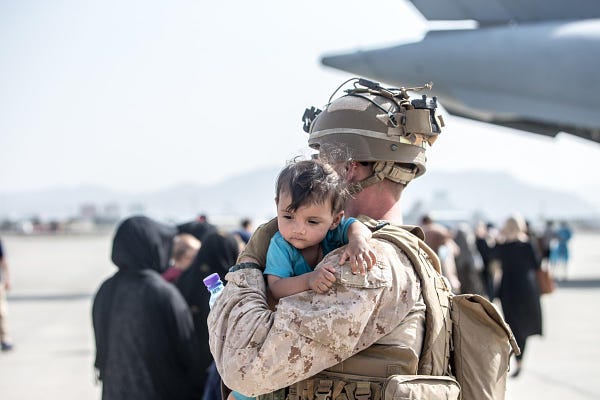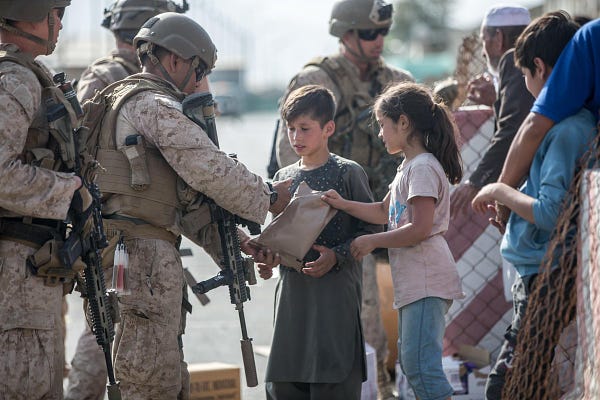We are more than a week into the Afghan evacuation. The operation has turned into something in between Dunkirk and the Berlin Airlift and seems to be going better than I would have thought possible when it started. Two weekends ago, I thought that we would be looking at a chaotic bloodbath as we had to fight to bring out the last Americans. The reality has been very different.
The AP reports that Monday was the biggest day for the evacuations so far with 10,400 people ferried out on 28 US military flights in 24 hours, followed by another 6,600 on another 15 flights during the next 12 hours. Those numbers dwarf the 3,900 removed in the first 24 hours of the airlift. As I was writing this article, a new one-day best total was announced, reporting that 21,600 passengers had been removed by US and Allied aircraft.




The total number of evacuees is almost constantly changing but Yahoo News reported on Monday that a total of 3,376 US citizens had been removed. The total number of evacuees, which includes Afghans who worked with the US military and the government, along with their families, exceeds 37,000.
And it has all been done without the loss of a single American life. A firefight erupted near the airport on Monday that left one Afghan soldier dead, but so far that is the only report of violence inside the pocket of territory held by Coalition forces.
The ability to continue the airlift without losses is due largely to the Taliban’s decision to stand down and let the evacuation continue. There is little doubt that Taliban forces could disrupt the flights to and from the airport as well as the loading process if they wanted to, but so far they are content to let the process continue.
The questions at this point are how many more Americans are left in-country to be evacuated, how they will be able to get to the airport, and how long the process will take. President Biden has not ruled out extending the airlift beyond August 31, but the Taliban considers that date non-negotiable. If the evacuation continues beyond the end of the month, the situation could get considerably more dicey.
As to the number of Americans, the government doesn’t seem to know exactly how many were in Afghanistan. As National Security Advisor Jake Sullivan explained to Yahoo, “The reason we can’t give you a precise number is because not every American who comes into Afghanistan goes and puts themselves into a database at the U.S. Embassy. They don’t have to. Many of them choose not to.”
State Department employees have reportedly been placing thousands of calls to try to determine the location of Americans that they believe may be in Afghanistan. They are also trying to determine whether the Americans that remain in-country want to leave.
Why wouldn’t Americans want to leave a country that is now under Taliban rule? They may want to stay with their families. They may be Muslims who are sympathetic to the Taliban like John Walker Lindh, the “American Taliban” captured in 2001. Some may even be staying to join the anti-Taliban resistance.
Early on, Defense Secretary Lloyd Austin told reporters that he did not have the “capability” to send units into the city to retrieve American citizens as England and France had done. That seems to have changed, however. Over the weekend, France 24 reported that American helicopters rescued more than 150 Americans who were unable to reach the airport gates.
But there may be more Americans out there. Fox News aired a phone call on Tuesday from a woman claiming to be in Afghanistan who said that her family was stranded at home.
“When we try to get to the airport, we either get beaten up or we are afraid for our lives,” the woman said. “For four days — three, four days — we didn’t hear anything from anywhere. And then they’re saying to go to the airport, but we’re not being given clear guidance. They are saying one thing and the next day they come and say something else. So you really exactly don’t know what to do. There is a lot of miscommunication going on.”
There have also been reports that Taliban fighters are confiscating passports from Afghan-Americans. It is not clear how widespread this practice has been, but more breaking news as I write this reports that the Taliban will begin blocking Afghans from the airport. This move could potentially strand thousands of Afghan allies and set up a confrontation between the Taliban and Coalition forces.
Putting all that together, there are at least seven days left in the airlift. If the current effort can continue, up to another 140,000 people can be evacuated before the Taliban slams the door on the effort. That will be a remarkable accomplishment in and of itself.
The more difficult problem is going to be accounting for the Americans who might or might not be in Afghanistan and might or might not want to leave. In the end, I don’t know if it will even be possible to know if we were successful in evacuating all of the US citizens who wanted to leave.
It is virtually assured that not all the Afghans who want to leave and escape the Taliban will be able to do so, however. I’m not sure that we could remove all the people who want to avoid living under Taliban rule if we stayed a year.
While the Afghan airlift is so far proving to be very successful, it does not erase the questions about why the situation in Afghanistan deteriorated so quickly. The Biden Administration has come under sharp criticism for not getting Americans and Afghan allies out earlier before we had to depend on the good graces of the Taliban to do so.
Those questions still need to be addressed, but if the Biden Administration can successfully evacuate the Americans stuck in Afghanistan, it will blunt much of the criticism directed at Biden’s foreign policy. After all, most of the country supports the withdrawal from Afghanistan but doesn’t like the way the evacuation has been handled. If the exit turns out to be less of a disaster than it originally seemed, Biden will almost certainly benefit.
No comments:
Post a Comment